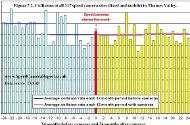2/10/2012
UK: Study Shows No Speed Camera Safety BenefitAccident analysis finds no measurable benefit to speed camera use in Thames Valley, UK.

A private study of the effect of speed cameras in Thames Valley, England concluded Tuesday that the devices failed to produce a measurable safety benefit. Dave Finney, an electronics engineer, produced the report by examining accident data from the Thames Valley Safer Roads Partnership before and after cameras were activated at 212 permanent sites and at all 105 locations where mobile photo radar vans were routinely parked. Most of the permanent installations were activated between 1993 and 1998.
The report focused on the effects in the 24 months before and 24 months after photo enforcement commenced at these locations. To compensate for changes in engineering and traffic volumes over time, Finney looked at the collisions at camera sites as a percentage of area-wide annual accident totals. He found that fixed locations saw a slight decrease in accidents and mobile sites a slight increase. Overall, the difference was a statistically insignificant 0.2 percent drop in collisions (view results chart).
The selection of before and after periods was deliberate. After 2000, all mobile camera sites had to be individually approved by the Department for Transport, a process that could take a year or more. This helped allow for correction of error due to selection bias. As a result, the year before camera activation is the most telling in the "before" period.
"Authorities choose locations for speed cameras following analysis of where collisions had occurred during the site selection period, and this process tends to favor selection of those sites where the numbers of collisions were higher than normal," Finney wrote. "Therefore collision rates would be expected to be lower after the site selection period, whether or not cameras had been deployed. This reduction that is caused by selection bias is often referred to as regression to the mean and, crucially, it occurs before the cameras are installed whereas any reductions due to cameras can only occur after they are installed."
According to Thames Valley surveys, speeds were reduced 4.7 MPH at fixed sites immediately after ticketing began at any given location. Thus, the 12 months after activation is the most telling in the "after" period.
"Because speeds reduced immediately, the rate of collisions should also have reduced immediately, suggesting that only the first year of camera operations need be considered," Finney wrote.
Finney provides all of the data and spreadsheets used for his analysis at his website. He has invited the Thames Valley speed camera partnership to check his work for accuracy. A motorist's rights group praised the current Conservative government for ordering full disclosure of all speed camera accident data.
"This investigation highlights what we have long suspected, that the whole speed camera fiasco has saved no lives and by diverting attention away from the real causes of accidents has actually cost lives," Association of British Drivers Chairman Brian Gregory said in a statement. "We are grateful to the government for forcing reluctant camera partnerships to reveal the previously hidden statistics which enabled this report but they must now acknowledge this abysmal failure and distance themselves from these disastrous policies."


